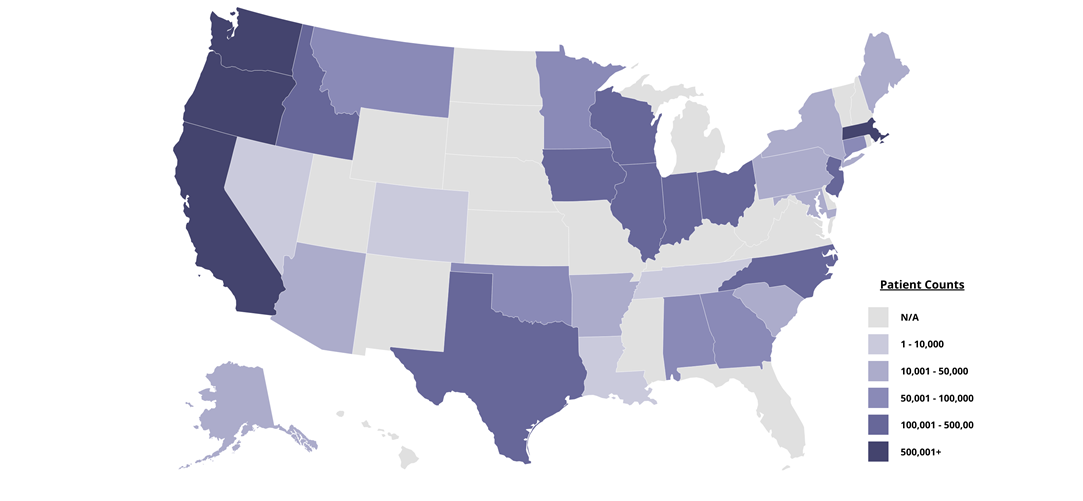About OCHIN and OCHIN Data
OCHIN, a nonprofit health care innovation center with a core mission to advance health equity, operates the most comprehensive database on primary healthcare and outcomes of traditionally underserved patients in the United States1. The OCHIN Epic EHR data warehouse aggregates electronic health record (EHR) and social determinants of health (SDH) data representing >6 million patients from 170 health systems and 1,600 clinic sites across 33 states (4.6 million patients are ‘active,’ with a visit in the last 3 years). Approved AIM-AHEAD projects can obtain access to up to 11 years of longitudinal OCHIN Epic ambulatory EHR data, which is research-ready on the PCORnet Common Data Model (CDM).
Contributing health systems are outpatient community-based health centers (CHCs), which deliver comprehensive, culturally responsive, high-quality primary care health care services for communities most impacted by health disparities. This includes individuals and families experiencing poverty, houselessness, migrant agricultural workers and veterans2. CHCs often provide on-site services such as dental, pharmacy, mental health, substance abuse treatment, and social work regardless of patients’ ability to pay.
1OCHIN leads and is the largest data contributor of the ADVANCE Clinical Research Network (CRN), a member of PCORnet®. The OCHIN RDW is an ADVANCE-supported product which has been developed with funding from the Patient-Centered Outcomes Research Institute® (PCORI®) (https://advancecollaborative.org/)
2https://bphc.hrsa.gov/about-health-centers/what-health-center
Explore the OCHIN Community Health Equity Database through Cohort Discovery, a web-based software tool for obtaining counts of patients matching user-specified inclusion/exclusion criteria. To gain access to Cohort Discovery, AIM-AHEAD program applicants must have completed and be up to date with standard training in Human Subjects Research and Responsible Conduct of Research. Access will be granted within 3 – 7 business days.
Overall Inclusion of Source Database
- Data years available for AIM-AHEAD: 2012-2023 (>72 million total encounters)
- Patients with one or more ambulatory, telehealth, or dental visit at a member clinic site on or after 1/1/2012
- Records from institutionalized patients and neonates (<28 days old) are excluded
| Key Characteristics of OCHIN EHR Data | Percent | Patient Count |
|---|---|---|
| Total all-time patients | 7,101,999 | |
| 100% and Below Federal Poverty Level (FPL) | 58.2% | 4,128,619 |
| 101% - to 200% FPL | 15.3% | 1,081,919 |
| Medicare | 8.2% | 585,477 |
| Medicaid | 48.3% | 3,432,708 |
| Uninsured | 25.2% | 1,791,784 |
| Spanish Speaking | 21.2% | 1,507,090 |
| Black | 16.8% | 1,190,194 |
| Hispanic / Latino/a/x | 32.9% | 2,338,934 |
| Asian | 5.3% | 375,337 |
| American Indian/Alaska Native | 1.0% | 73,579 |
| Diabetes1 | 12.6% | 458,877 |
| Hypertension1 | 24.1% | 874,591 |
| Asthma1 | 9.4% | 342,743 |
| Chronic Kidney Disease1 | 2.5% | 90,567 |
| Mental/Behavioral Health Dx1,2 | 28.0% | 1,017,598 |
| Obesity1,3 | 37.8% | 1,372,106 |
| 1Chronic condition percentages presented among active adult patients (N=2,842,576)
2Includes anxiety, bipolar, depressive disorders, schizophrenia, and other psychotic disorders 3Obesity diagnosis on problem list or last-recorded BMI >30 |
||
Available Data at a Glance
| Domain | Example variables |
|---|---|
| Demographics | Sex, age, race, ethnicity, language, FPL, sexual orientation, gender identity, vital status/death date, state, and zip code of residence. |
| Encounters | Encounter type, level of service, provider type, date. |
| Diagnoses (from encounters, problem list, and patient-reported medical history) | ICD-9 and ICD-10 diagnosis codes, description, date. |
| Procedures (from encounters and patient-reported surgical history) | CPT and HCPCS procedure codes, description, date. |
| Vitals | BP, BMI, and tobacco use measurements, measurement date. |
| Laboratory results | Lab type (standardized to LOINC), specimen source, date, result. |
| Medications (prescribing and dispensing) | RxNorm, NDC, medication name, dose, quantity, route, frequency, refill count. |
| Patient-reported outcomes | Screening questionnaire responses (e.g., PHQ2, PHQ9, AUDIT), screening date. |
| Immunizations | Immunization type, dose, administration date. |
| Social determinants of health | Patient-level social needs screenings recorded in EHR, e.g., food insecurity, housing quality, housing insecurity, transportation needs, education, employment. |
| Area-level social and environmental data | Geographically linked neighborhood-level indicators at census tract and/or ZCTA level. OCHIN facilitates direct linkage to CDC’s Environmental Justice Index and AHRQ’s Social Determinants of Health Database. |
OCHIN Patient Distribution by Facility's State


